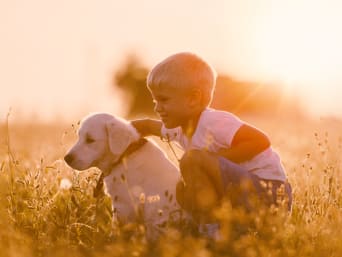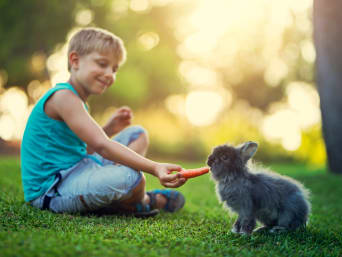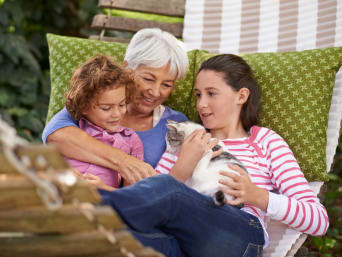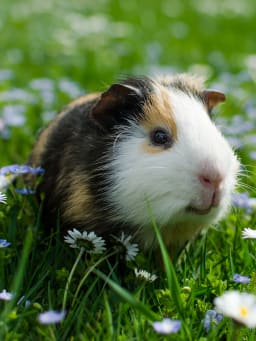The best pets for children
Lots of children want to have a pet whether it's a dog, cat, hamster or guinea pig. Pets can be a friend and loyal companion for a child for many years and therefore also have a positive influence on a child's development. However, not every type of pet is equally suitable for every age or for every family. To ensure that both your children and your pet are safe and get on with each other, there are a few things that you should consider before welcoming a pet into your home.
Contents
What types of pets are suitable for children?
Dogs and cats as pets for children
Small pets for children
Birds, fish and exotic animals as pets for children
How do I know when my child is ready for a pet?
If your children enjoy visiting farm parks at weekends or during the school holidays, then they may start asking whether they could have a pet. However, when is the right time to get a pet for a child?
Tips on finding the right pet for your children
To help you find the right pet for your family have a look at our helpful tips below:
Pets for children aged 3 and over: at this age children should not take on the responsibility of having a pet. However, with parental supervision and support, they can help and spend time with pets such as cats or guinea pigs. Young children should always be supervised and should not be left alone with any pets.
Pets for children aged 6 to 9: school-aged children can gradually take on more responsibility. You will need to show them which tasks they will need to start so that they can take care of their pet. At this age, children slowly learn the basic skills needed to take on certain tasks, for example, your child should already be able to understand numbers and read a clock in order to give your pet the correct amount of food or to understand when your pet goes to sleep.
Pets for children aged 10 and over: older children will be able to take on the responsibility of looking after a pet and taking on more tasks. From around 11 or 12 years of age, for example, they can also take the dog for a walk. Teenagers also have more understanding for the animal’s individual needs.

Before getting a pet it is important to think about whether you and your family will have enough time to look after your pet and give it the attention it needs. Parents generally will have to complete most of the daily tasks in caring for their pet until small children and school-aged children are a bit older to take on more of a responsibility.
From what age can a child take on more responsibility in caring for a pet?
There is no one size fits all answer to this question. Nevertheless, there are some general signs that you can use a guide, for example, young children can still be clumsy when it comes to handling animals, as they often still lack the necessary fine motor skills. From an early age some children can be quite mature for their age. Therefore, it is a good idea to think about how mature and whether your child would be capable of taking care of a pet.
The questions below will help you to assess whether your child is ready to take on the responsibility of having a pet:
Does your child tidy up their room on their own?
Does your child regularly wash their hands without needing to be told?
Does your child respect the rules and boundaries you have made?
Can your child distinguish the difference between playtime and bedtime?
You can use these questions to determine whether your child is mature enough to follow any rules around having a pet and to take on tasks independently. However, this doesn't mean that your child can look after a pet all by themselves. At the beginning, you should always help out and keep an eye on whether your child can complete certain tasks on their own.
You should also teach your child how to treat any animal with respect. Especially with small children, always make sure that your child does not pull the animal’s fur, hit or is too rough with it. If an animal feels threatened or provoked, it could unexpectedly snap. Show your child the best way to touch or stroke your pet. If your child learns from the start how to treat animals, then taking care of pets will become easier, safer and your pet will also feel more comfortable.
What types of pets are suitable for children?
When choosing the right pet, it's not just the amount of care and time required that counts, but also the costs of buying and also looking after a pet. Don’t forget not all animals are tame or like to be stroked. Discuss with your family what type of pet you would like to have. If you take these factors into account when making your choice, it will be a lot easier to find the perfect pet for you and your family.

Before buying a pet, you should make sure that no family members have any allergies. Not only dog and cat hairs, but also the hay or bedding for small animals or mites in bird’s feathers can trigger allergic reactions.
Dogs and cats as pets for children
Dogs are generally loyal, friendly and loving, which makes them the ideal companion for humans. Parents will need to make sure that their dog is brought up properly and knows how to behave. However, even small children can pet and play with a dog under supervision. As a parent, you should make sure your children or dog do not overstep their boundaries and do not run riot. Depending on the breed, dogs need a lot of attention and care, therefore, you will need to be prepared to set aside several hours a day for exercise and play time. Children are not yet able to fulfil such tasks independently. As children get older, however, they can gradually take on more responsibility for a dog, such as taking it for walks.
Cats are a loyal and loving companion, but they are much more independent. They are more sensitive and decide for themselves whether they want to be stroked and do not always enjoy being cuddled. Children should therefore be shown how to carefully look after cats. Children need to understand that animals sometimes do not want to be disturbed and may want to spend some time on their own. With the help of their parents, nursery and school-aged children can stroke and play with their cat. Toys such as cat fishing rods or play sticks with feathers are particularly suitable for this, as the cat can be kept busy safely from a certain distance. However, how friendly and how much attention a cat needs depends on its individual character.
Which type of pet is suitable for children. A comparison of dogs and cats
Dogs | Cats | |
|---|---|---|
Recommended age | For children aged 10 to 11 | For children aged 6 and over |
How much time they need | Around 2 hours per day | Around an hour a day |
Ideal as a pet for small children | Never leave children and dogs alone. Children should only pet and play with dogs when there is an adult present. | Cats should only be played with or petted when there is a parent present. You will also need to talk to your child about how to behave and the rules concerning stroking and playing with your cat. |
Suitable as a pet (depends on the breed and the pet’s character) | Friendly, loyal, affectionate and enjoy playing. They like to be cuddled as long as they don’t feel pestered. | Gentle, playful nature, rather independent. They like to be stroked, but also enjoy spending time on their own. |
Can they be kept inside and on their own? | Yes, but they need regular exercise and your undivided attention. | Cats should be kept indoors, but make sure you have a cat flap so that they can go outside and come back in. If your cat has no access to an outside space make sure that they have plenty of room in your home. |
Life expectancy | On average 8 to 16 years | On average 12 to 20 years |

You should put hutches, the animal’s bowls or sleeping areas in a quiet corner of your home. This will give your pets the peace and quiet they need and a place to retreat where they can spend time by themselves where they won't be disturbed.
Small pets for children
Small pets generally take up less space than a dog or cat, but the necessary care and keeping their hutch or cage clean and tidy is not always easy. Birds, rabbits and guinea pigs are often skittish, but with time they will get used to you and their new surroundings if they are well look after. A tame rabbit can be stroked but does not like to be picked up and carried around. As a result, this may break the trust that you have with your rabbit.
You will need to supervise small children with small pets in particular, as they could end up being a bit too rough or they could drop them by mistake. Guinea pigs are quite shy and they usually don't like being stroked. They can quickly become quite anxious if you put them on your lap and pet them.
It is important to work together with your child to gain your pet’s trust. Lots of small animals become tame and can be fed from your hand. This will ensure that they are happy and kept in a stress-free environment. Feeding small pets from your hand is something children will also enjoy. Older children and teenagers already have more patience and understanding for the needs of small animals and therefore also animals such as hamsters that are more active in the evenings. Older children will also understand that hamsters enjoy being left alone. It is important that children learn how to respect and properly look after their pets in an appropriate way from an early age.
Information on small pets for children
Guinea pigs | Rabbits | Hamsters | |
|---|---|---|---|
Recommended age | For children aged 8 and over | For children aged 10 and over | For children aged 14 and over |
Important facts | Like to move about and need space to freely run about in | Like to move about and need space to freely run about in | They are more nocturnal and they need enough space to hide, dig and burrow |
Activities | You can feed and observe them | You can observe, feed and stroke them | You can feed and observe them |
Can they be kept on their own? | No, they are very sociable and can quickly feel lonely | No, they are very sociable and can quickly feel lonely | Yes |
Life expectancy | On average 5 to 8 years | On average 8 to 10 years | On average 2 to 4 years |

Even when handling pets carefully, the odd scratch is often unavoidable. Make sure to clean any small cuts or scratches and, if necessary, apply a disinfectant that does not sting.
Birds, fish and exotic animals as pets for children
Popular bird species such as budgies and canaries need plenty of space and somewhere to fly freely on a regular basis. Although most pet birds are lively and "talkative", they do not like physical contact. Nevertheless, they are easy to feed and take care of. They are a great choice for primary school children who can already take on the responsibility of looking after them.
Pet fish should never be picked up and petted. Aquariums are more for looking at and they can also have a calming effect. This is something that may not really interest younger children. If your child wants to take on the responsibility of looking after pet fish, you should find out about how they need to be cared for and what exactly you will need. Depending on the fish species, this can be very demanding. Aquariums are therefore only recommended for older children.
Exotic pets are fascinating for children, but not necessarily recommended for families due to them being demanding and the associated risks. Find out exactly what you will need and consider whether you would be able to look after them.
How to teach your child to be responsible for a pet
When a new pet joins the family, it is an exciting and happy time for children and parents alike. By getting a pet, children can gradually learn to take on more responsibilities and show respect and consideration towards others.
Below you will find some useful tips on how to teach your children to take on the responsibility of looking after a pet:
Find out together: the amount of care and time required for different types of pets can differ. You will also need to find out about how they need to be kept as well as what you will need. It is a good idea to discuss this as a family and divide up the different tasks. Bringing a pet into your family is not a decision that should be taken lightly. Also discuss the long-term responsibilities, as the pet will be with you for a long time and will be reliant on you to look after it.
Start with smaller tasks: certain aspects of care can still be too difficult, especially for small children, such as taking on the responsibility of cleaning a hutch or cage. Younger children can complete easier tasks, such as giving your pet some water, filling up their food bowl or gently brushing their fur.
Offer your child support: in the beginning, children still need a lot of guidance and help, but as they get older they become more aware of their responsibilities. From around 10 to 12 years of age, children will become a lot more independent.
Be a role model for your children: it is recommended to show older children how to take care of pets properly. This also includes explaining how to stroke your pet, whether it can be picked up and when it should not be disturbed. You should also show your children how to clean up after your pet.
As a parent, you are responsible for the animal's care, but your child can (and should) support you in looking after your pet. This will help them to become more patient and to take on a sense of duty and responsibility.
Conclusion: which type of pets are suitable for children?
A pet will help your child to become more independent and to take on a role of responsibility. Children's self-confidence and self-esteem are also boosted when they are allowed to look after their pet and gain the animal's trust and affection. However, not every type of pet is equally suitable as a child's "first" pet. You as the parent should be able to guarantee that your pet will be well looked after and it will have everything it needs. This will also help to teach your children to become more responsible. By doing so, you will not only fulfil your children’s wish, but also ensure that everyone is happy and well looked after.
______________________________________________
References and further information
https://forevervets.com/blog/6-best-pets-to-consider-for-your-child
(Last accessed on 21.02.2024)
https://www.petassure.com/new-newsletters/caring-for-pets-teaches-children-responsibility/
(Last accessed on 21.02.2024)
https://www.petsathome.com/pet-talk/choosing-a-pet-which-pet-is-right-for-your-lifestyle-children
(Last accessed on 21.02.2024)
https://pridebites.com/blogs/barking-post-blog/how-to-teach-your-kids-about-pet-care
(Last accessed on 21.02.2024)
The image sources in this text are in chronological order
Cover photo: iStock.com/MarkoNOVKOV
1. Image in text: iStock.com/Imgorthand
2. Image in text: iStock.com/skynesher
3. Image in text: iStock.com/PeopleImages








